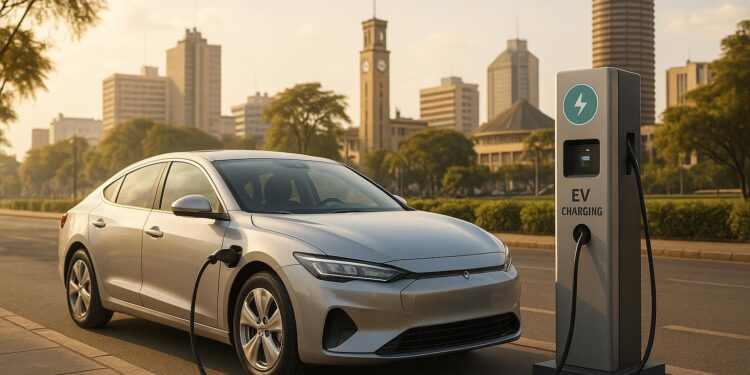Kenya is ramping up efforts to make electric vehicles (EVs) more accessible and practical for its citizens. The government is introducing measures like tax breaks, expanding charging infrastructure, and setting safety standards to encourage EV adoption. With 93% of its electricity coming from renewable sources as of 2023, Kenya is uniquely positioned to reduce transportation-related emissions significantly. Key highlights include:
- Tax Incentives: Lower import duties, VAT exemptions, and reduced registration fees to cut upfront EV costs.
- Charging Network Expansion: Plans for nationwide charging stations, including residential and commercial areas.
- Safety Standards: Stricter regulations for EV batteries and vehicle inspections to ensure quality.
These policies aim to reduce fuel dependency, lower transportation costs, and create new business opportunities in areas like battery recycling and local assembly. However, challenges like high EV prices, limited rural infrastructure, and reliance on imported components remain barriers. With strong leadership and investment, Kenya could become a leader in clean transportation across Africa.
Taxes Threaten Chinese EVs Adoption in Kenya
Key Policies Supporting EV Adoption
Kenya is building on its existing energy initiatives by focusing on policies that encourage the use of electric vehicles (EVs). The government is working on a framework to tackle obstacles like high upfront costs, limited charging infrastructure, and the need for reliable safety standards.
Tax Breaks for EV Buyers
To make EVs more affordable, the government plans to lower or eliminate excise and import duties, offer VAT exemptions on EV-related equipment, and reduce registration fees. These measures aim to ease the financial burden on potential EV buyers.
Charging Station Development
A nationwide network of charging stations is in the works, with plans to place them along major highways, in commercial areas, and within residential neighborhoods. The government also aims to involve private businesses and introduce discounted electricity rates during off-peak hours to support this infrastructure.
Safety and Quality Standards
To ensure safety and reliability, the Kenya Bureau of Standards (KEBS) will implement stricter regulations for EVs. This includes certification processes focusing on battery safety and vehicle inspections. These standards are designed to ensure that all EVs, whether imported or locally made, meet modern safety and environmental requirements.
These initiatives aim to address key challenges and lay the groundwork for broader EV adoption, with further impacts on consumers and businesses explored in the next section.
Impact on Consumers and Businesses
The proposed electric vehicle (EV) policies are set to reshape the landscape for both individual car buyers and businesses in Kenya. These measures aim to alter transportation cost dynamics while unlocking new opportunities in the automotive sector. Below, we break down how these policies affect costs for EV owners, create business opportunities, and highlight challenges for local EV production.
Cost Savings for EV Owners
Owning an electric vehicle could lead to substantial financial advantages over time compared to traditional gasoline-powered cars. For starters, electricity costs less per mile than gasoline, and EVs have fewer moving parts, which means lower maintenance expenses. On top of that, tax incentives like reduced import duties and VAT exemptions are designed to make the upfront purchase of EVs more appealing. Combined with lower operating costs, these measures could help narrow the price gap between EVs and conventional vehicles in the long run.
Business Opportunities in Kenya
The shift to electric vehicles is creating a wealth of opportunities for Kenyan businesses and entrepreneurs. For instance, battery servicing and recycling are emerging as lucrative areas for investment. Local assembly partnerships also hold promise, potentially reducing reliance on imports while generating jobs. Additionally, businesses in vehicle service and repair will need to adapt by acquiring the expertise necessary to cater to EV-specific technologies, opening up further revenue streams. These developments could significantly transform Kenya’s automotive market.
Local Manufacturing Challenges
Despite the potential, local EV production faces significant hurdles. High initial investment costs and the complexity of supply chains make manufacturing a challenge. Critical components like battery management systems, electric motors, and control electronics often need to be imported, which can erode the cost benefits of producing EVs locally. Moreover, global manufacturers with economies of scale present stiff competition. Another pressing issue is the skills gap in areas like electric drivetrain design and battery technology. To address these challenges, strong government support is essential – whether through technical assistance, financing, or procurement guarantees – to ensure the viability of local production efforts.
sbb-itb-e5ed0ed
Climate and Market Effects
Kenya’s push for electric vehicles (EVs) is reshaping both its environmental outlook and the automotive industry, with ripple effects on the broader economy.
Cutting Carbon Emissions
Transportation is one of Kenya’s largest sources of carbon emissions. Shifting to electric vehicles is seen as a key step toward achieving national climate goals. EVs produce no direct emissions, offering a way to improve air quality in cities like Nairobi and Mombasa, where heavy traffic contributes significantly to pollution.
What makes Kenya’s case particularly promising is its clean energy grid. With renewable energy powering EV charging stations, the overall carbon footprint of electric vehicles is even smaller compared to traditional gas-powered cars.
This transition aligns with the Paris Agreement‘s goals, positioning Kenya to reduce greenhouse gas emissions significantly. Replacing conventional vehicles with electric ones could lead to notable CO₂ reductions, while also opening the door to market growth supported by favorable policies.
Market Growth and Future Projections
The EV market in Kenya is still in its infancy, but there’s growing optimism about its potential. Consumer savings on fuel and maintenance, combined with new business opportunities, are setting the stage for growth. With strong policy backing and improved infrastructure, analysts predict that the number of EVs on Kenyan roads could climb significantly in the coming years.
The commercial vehicle sector stands out as a promising area for EV adoption. Ride-hailing services and delivery companies are already exploring electric options to cut operating costs. Meanwhile, advancements in battery technology are driving down costs, which could make EVs more competitive with traditional vehicles and speed up adoption.
Making EVs More Accessible
Despite the promise, several barriers still limit the widespread adoption of electric vehicles in Kenya. One major issue is affordability. Even with tax incentives, EVs tend to have a higher upfront cost compared to gasoline-powered cars, making them less accessible to many buyers.
Financing is another hurdle. Traditional auto loans often fail to account for the long-term savings EVs offer through lower operating costs. This creates a need for financing solutions that reflect the total cost of ownership, making EVs more appealing to buyers.
Charging infrastructure is also unevenly distributed. While cities like Nairobi are seeing improvements with new charging stations, rural areas remain underserved. This disparity highlights the need for broader infrastructure development. Additionally, electricity grid reliability in some regions poses challenges for consistent EV use, emphasizing the importance of grid upgrades.
Lastly, Kenya’s vibrant used vehicle market currently offers few electric options. As global EV adoption grows, a more active second-hand market for electric vehicles could emerge, making eco-friendly transportation more accessible to a larger portion of the population. This shift could play a critical role in expanding EV adoption across the country.
Conclusion: Kenya’s Path to Clean Transportation
Kenya stands on the verge of a major shift toward cleaner transportation solutions. This journey is built on three key elements: policy incentives, infrastructure development, and market readiness. Together, these factors provide the foundation for Kenya to emerge as a leader in adopting cleaner, greener transportation options. They also build upon earlier efforts, paving the way for a more sustainable future.
Strong and determined leadership at both the state and local levels will be essential to turning these plans into action. With the right commitment, Kenya has the potential to transform its transportation systems and make lasting progress toward sustainability.
FAQs
What tax breaks is the Kenyan government offering to make electric vehicles more affordable?
The Kenyan government is taking steps to make electric vehicles (EVs) more accessible by offering tax exemptions. EV buyers are now completely exempt from the usual 16% Value Added Tax (VAT) and the 10% excise duty that typically apply to vehicle purchases. These changes cut down the initial cost of owning an EV, making them a more appealing choice for consumers across Kenya.
How does Kenya’s use of renewable energy enhance the environmental benefits of electric vehicles?
Kenya stands out by producing over 90% of its electricity from renewable sources such as wind, solar, and geothermal energy. This clean energy foundation means that charging electric vehicles (EVs) in the country results in minimal carbon emissions, amplifying the environmental benefits of switching to EVs.
For drivers in Kenya, transitioning from traditional gas-powered vehicles to EVs can lead to a significant reduction in their carbon footprint – around 4 to 5 metric tons per year. This shift plays a crucial role in advancing Kenya’s sustainability goals and addressing the challenges of climate change.
What are the main challenges Kenya faces in building EV charging infrastructure, especially in rural areas?
Kenya is encountering several hurdles in building up its EV charging network, especially in rural areas. A major roadblock is the limited capacity and inconsistent reliability of the electricity grid, which complicates efforts to set up charging stations outside urban hubs. Rural areas also tend to have lower population densities and fewer EV users, making it less appealing for businesses to invest in charging infrastructure.
Adding to the difficulty is the high cost of installing and maintaining charging stations, a significant obstacle for both businesses and local governments. When paired with the limited driving range of many EVs, these challenges make it tough to guarantee widespread access to charging facilities in remote regions. Overcoming these barriers will be crucial for encouraging broader EV adoption throughout Kenya.
Related Blog Posts
- Guide to Electric Vehicle Charging Stations in Kenya
- EV Charging Stations in Nairobi: Where and How to Recharge
- Kenya opens East Africa’s first EV battery lab in Nairobi
- MojaEV launches NETA V electric car in Kenya




